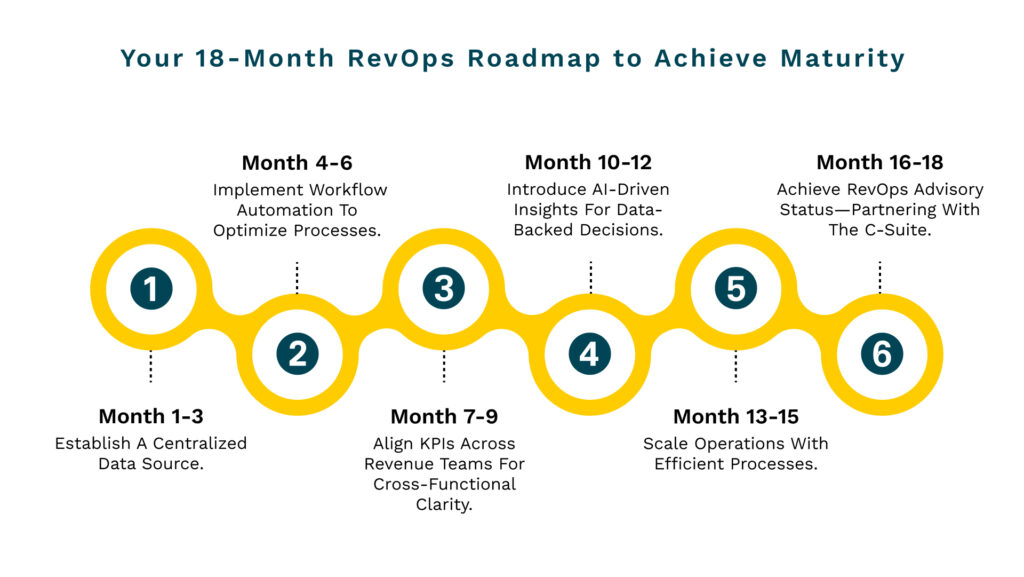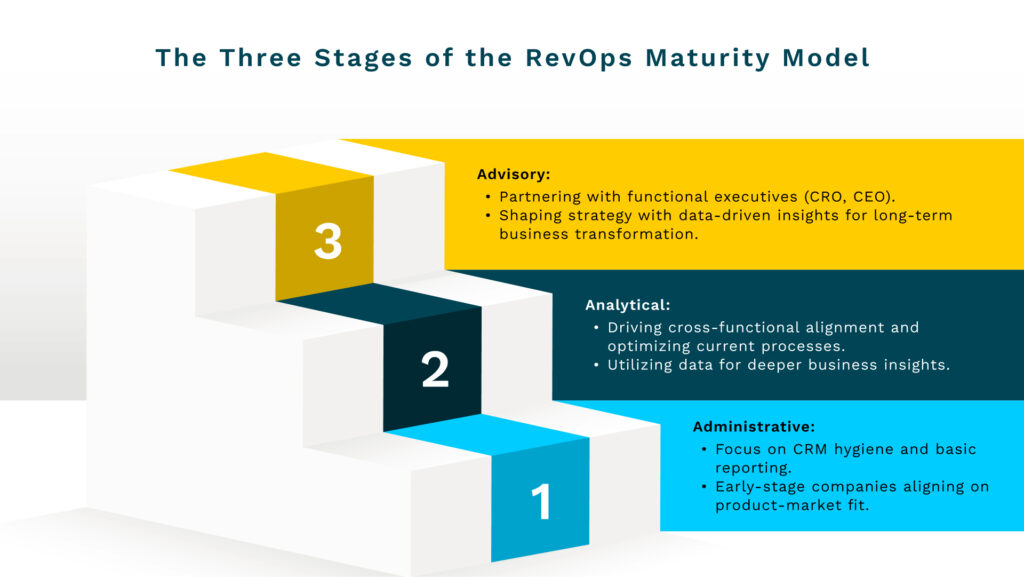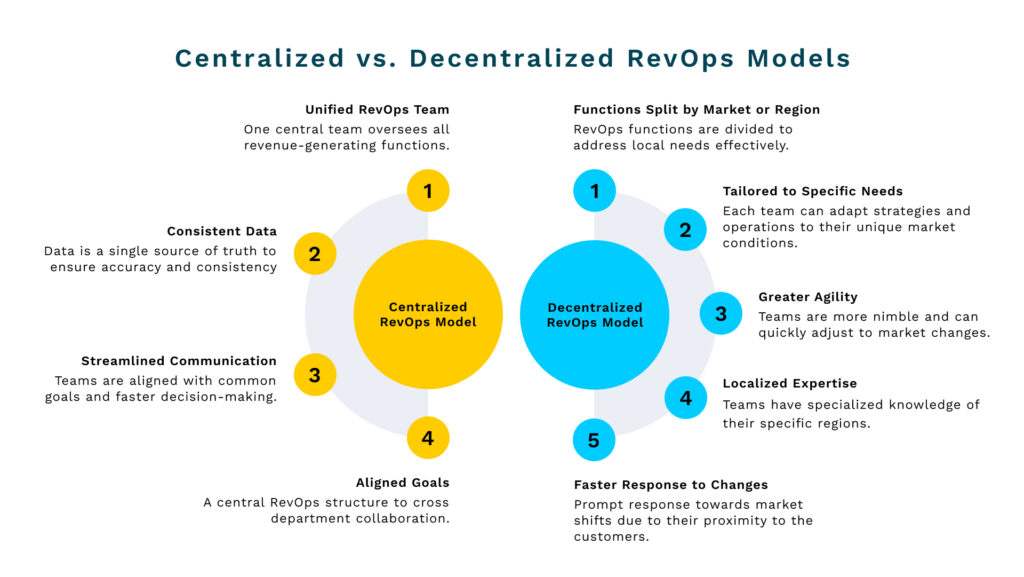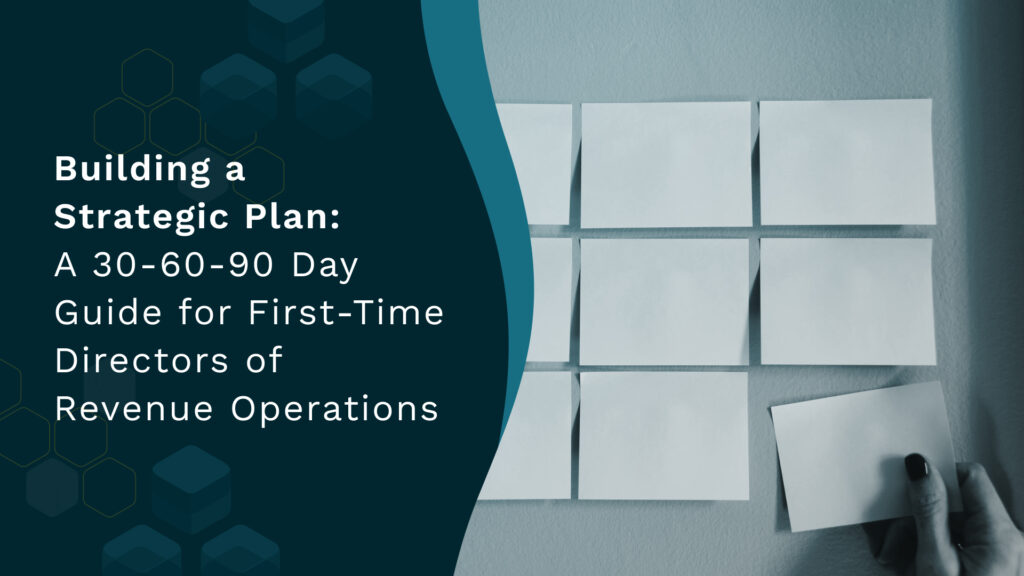
RevOps Maturity Model: How to Build, Measure, and Optimize for Success
Gain insights on RevOps maturity model, strategies for alignment across GTM functions, key metrics, KPIs, and common pitfalls to avoid.
In the current B2B SaaS environment, it is imperative to have a functional RevOps strategy to build upon a functional RevOps Maturity Model. RevOps leaders must change, reinvent their practices and strive for improvement as the business grows and enters new markets .
We recently had a chance to speak with Richard Sgro, SVP of Sales & Customer Success at Insight Partners,a private equity firm with over $80 billion in assets under management. He has over 15 years of experience in product, sales, and revenue operations roles.
Richard dived into the nitty gritty of RevOps maturity model including unveiling the strategies for aligning GTM functions, metrics to tracks and pitfalls to avoid. In this guide, we are bringing you a comprehensive take on all the essential takeaways from the conversation in case you missed attending the webinar. This guide is aimed to help you upgrade your company’s current state of RevOps maturity while building a solid vision for the future.
A RevOps maturity model has been gaining prominence across organizations for its ability to provide a holistic view of the customer journey and ensure a sustainable growth. The RevOps leaders can pinpoint strengths, omit weaknesses and drive better business growth by having an understanding of different maturity stages
Let’s unpack this in detail.
What is the RevOps Maturity Model?
The RevOps Maturity Model describes the stages a RevOps function progresses through. From being merely an operational function, it evolves into a strategic function that drives real organizational impact. The model helps companies identify their current RevOps position and the gaps to improve effectiveness.
Data quality, process optimization, cross-functional collaboration, and strategic integration highlight current RevOps maturity levels. The model helps organizations assess the state of their RevOps.

Some of its benefits include:
1. Improved Alignment
Makes sure sales, marketing, as well as customer success are pursuing the same key objectives in order to minimize conflict and foster collaboration.
2. Data-Driven Decision making
You get access to information from all departments so that every important decision is rooted in facts.
3. Superior Customer Experience
Bridges gaps so that customers do not have to go through a fragmented experience from being acquired and eventually being retained.
4. Increased Scalability
Keeps increasing efficiency by redesigning processes as well as enhancing technologies in order to handle growth and expansion effectively.
Core Components of a RevOps Maturity Model
At the heart of each successful RevOps maturity model is a functional spectrum that enable an organization to run in an effective manner. Let us go further and define these components:
1. Strategy and Planning in a RevOps Maturity Model
In any revenue streaming operation, strategic planning is at the center of everything. It requires determining the company’s revenue goals as a direction and also making sure that all teams are aligned.
a. Operating Plan Development
RevOps leaders are in charge of formulating an operating plan which includes the revenue goals, initiatives and the use of resources within the firm.
b. Headcount and Territory Planning
Planning within RevOps involves data analytics so that the sales efforts are optimized and with accurate mapping of territories and quotas, maximum coverage and revenue potential can be unlocked.
c. Quota Setting
RevOps leaders apply quota setting both internally and externally within the organization.
2. Data and Analytics for a RevOps Maturity Model
There is hardly any successful RevOps function with no data. Understanding how to collect, analyze, and effectively turn such information into money-generating machines is important for a successful RevOps Maturity model. The RevOps team collects data through:
a. Board Level and Functional Reporting
Includes high level reporting to the executive team providing information that is consistent with determined strategic objectives.
b. Go-to-Market (GTM) Reporting
Distribution of the budget over such departments as sales, marketing and customer success on KPIs relating to the success of market penetration based on existing resources.
c. Data Visualization and Management:
RevOps teams access and apply modern resources for data visualization, utilizing advanced dashboard tools.
Related: 10 RevOps Best Practices to Follow in 20243. Systems and Processes within a RevOps Maturity Model
RevOps significantly impacts technology stack management and organizational processes. Therefore, teams must put systems in place to direct RevOps towards the main goal.
a. Tech Stack Management
The RevOps team evaluates, selects, implements, and interlinks technologies, such as, CRM systems, marketing automation systems, and other analytics systems that enable revenue operations activities.
b. Process Optimization
Expediting workflows is essential to add and remove barriers, improve effectiveness, and facilitate ease of working relations across teams.
c. Vendor Management
Responsible for the management of third parties so that the organization’s needs regarding technology are met at a reasonable cost.
Related Blog: Your Guide to Creating a Winning RevOps Strategy4. Support and Enablement for a RevOps Maturity Model
RevOps teams train and support the workforce, including enablement functions for all revenue-generating teams.
a. Training and Skills Development:
RevOps teams conduct workshops and Salesforce courses on sales methods and sales management tools.
b. Sales Enablement:
Furnish sales personnel with much-needed tech stack which is just right and enables them to do what they must do- sealing those deals.
c. Infrastructure Support:
RevOps teams monitor lead management, quote to cash, and deal desk parameters. These are core infrastructure components and are critical for organizational functioning.
Sales enablement is not only about providing the sales team with the necessary tools but designing an ecosystem within which the sales personnel can interact with customers and convert them more proficiently. Thus, it calls for improvement of sales engagement content, development of sales playbooks, and offering help instantaneously during the sales process.
Likewise, infrastructure support extends beyond the management of systems, such as CRM systems. RevOps teams ensure that all revenue-related activities, from lead generation through closure, are seamless and efficient. This includes the management of quote to cash processes along with the integration of different teams working on the sales, marketing and customer success across different stages of maturity.
Stages of the RevOps Maturity Model
As per Richard, there are three stages of the RevOps Maturity model. Let’s explore each of them:

1. Administrative Stage of RevOps Maturity
Considering this as a beginning step, RevOps handles primary operational functions like data governance, CRM administration, and routine reporting at this stage. The aim is to design efficient operations that ensure data accuracy.
a. Typical Features that Define the Administrative Stage:
During this stage, RevOps teams focus on data collection and maintaining customer relationship management systems. RevOps teams ensure that information is relevant, current, and well-structured to facilitate fundamental reporting.
RevOps teams facilitate the function through basic process optimization and system management. They enhance processes by minimizing redundancy and supporting core operations.
b. Challenges Faced in the Administrative Stage:
Team Siloes:
Substantial departmental participation for work teams in the organization does not exist as Sales, Marketing, and Customer Success often operate as separate functions, with limited departmental participation.
Absence of tactical contribution:
Organizations often regard RevOps as a support function rather than a strategic unit. This inhibits its ability to influence business decisions.
2. Analytical Stage of RevOps Maturity
RevOps begins to make more use of the data in assisting with insights generation and collaboration at this level. The emphasis is on analyzing the data collected and driving better strategic decisions using it.
a. Characteristics of the Analytical Stage:
RevOps teams leverage data analysis and insight generation to their full potential. RevOps teams study data of their target market to find patterns, to analyze customer behavior, and to evaluate potential steps for revenue growth
The function leverages data to align others. As a central source of information, RevOps ensures that all the relevant teams are oriented at the same goal and equipped with the same data.
b. Challenges Faced in the Analytical Stage
Ensuring Data Accuracy:
As the stage depends more on data, the need for consistent, reliable, and accurate data increases.
Balancing analysis with actionable insights:
Any data is possibly redundant if necessary insights can not be made out of it. The RevOps team must implement the key learnings in practice otherwise the gathered data is merely a bunch of numbers.
3. Advisory Stage of RevOps Maturity
At the highest level of maturity, RevOps takes the mantle to execute leadership as well. At this stage, it works at par with other leadership roles to strategize business growth, increase operational efficiency and drive initiatives.
a. Key Features of the Advisory Stage:
RevOps acts as a strategic partner to executive leadership at this level. The insights and strategies provided by it are aimed towards driving the overall growth of the organization
The function facilitates business transformation through taking on key initiatives such as innovations in market entry, new business streams or enhancing customer relations.
b. Challenges Faced in the Advisory Stage:
Prioritization of strategy and scope:
The strategic pivot of RevOps only gets complicated, as more intricate duties come along that necessitates prioritization of action over others tasks
Efficient execution and strategic focus:
The RevOps leaders have the pressure to balance between operational efficiency with the execution and attention to broader strategic objectives.
This brings us to the next important question: what can be the scope and design of RevOps Model where the teams function?
Deciding the Scope of RevOps Maturity Model: Centralization vs. Decentralization
Organizations frequently revisit and modify the scope and structure of the RevOps function to match their growing needs. When an organization wants to implement a high performing RevOps function, it should figure out whether it wants to centralize or decentralize the RevOps.

Organizations consider variables like size, market complexity, and maturity stage when choosing between centralization and decentralization.
1. Centralized RevOps Model
A centralized RevOps model takes all the revenue operations activities into the revenue unit under one operating umbrella and therefore uniform in thinking and in practice within any revenue unit.
Advantages of Implementing a Centralised RevOps Structure
With a centralized RevOps system, all the revenue-related activities are brought together and led by one head and its advantages include;
– Streamlined Strategy and Implementation:
This helps in the uniform execution of revenue strategies across all the teams.
– Data Accuracy Improvement:
In the management of data that is siloed, having a single source of information is guaranteed.
– Collaboration Barriers Relaxation:
Centralizing RevOps improves team communication within organizations.
Some of its drawbacks can be:
Longer periods may be utilized in resolving an issue because of the bureaucracy that comes with centralization.
Lower levels of fast adaptation to the changes that may happen in the market
2. Decentralized RevOps Model
In this model of RevOps, the RevOps functions are divided into teams or departments and each team works within its discipline, though it ensures that it works toward the common goals of the established business organization.
Advantages of Implementing a Decentralised RevOps Structure
Organizations gain more options and adaptability, especially to meet the needs of different teams.
Fewer barriers make it possible for issues to be addressed quickly.
Knowledge development in specific areas where there is division – for example, marketing management teams may acquire supervision specialists and want further skill certification.
Potential shortcoming can be:
A silo mentality may prevent organizations from achieving their objectives.
Procedural and information-handling discrepancies may occur.
In the beginning stages or at the scale up stage of the organization, centralization of RevOps helps in normalizing the procedures, the way data is handled and communications. A centralized RevOps structure places all revenue-related activities under one leader focused on strategy, planning, and implementation. However, when the organization grows, centralization may also become a bottleneck and decentralization is seen as a strategy for narrowing the overall goal and providing flexibility.
Organizations can turn their RevOps principles into both tactical milestones and unfettered goals, meaning, the pros and cons of centralization and decentralization ought to be considered in every strategic turn.
3. When to Consider Scattered RevOps Tasks
In some instances where the operating structure becomes rather large, a few of those roles rather RevOps responsibilities could be distributed and be of benefit delving into the following;
Specialized Skills
Organizations can distribute operations like quota setting, compensation management, and territory design to leverage specialized skills.
Flexibility
Reliability of teams may be improved by decentralization which can pour greater and improved response to the changes imposed in the area or that of the customers.
Focus on Strategic Goals
Takes care of important aspects of RevOps while managing non-critical responsibilities by leveraging other teams.
Structuring a RevOps Team as per Growth Stages
After establishing the structure, the next step would be forming of the RevOps team to ensure its proficiency in growing the organization. RevOps teams call budgets and resource planning into action to ensure effectiveness across all phases of growth.
Implemented changes reflect in the organizational structure as RevOps teams grow at different levels:
1. Early-Stage Organizations
In such organizations at an early stage, RevOps teams tend to be few in size but extremely flexible in roles: Genistar Model: A director-level generalist heads the RevOps with support of a subordinate system’s expert, for instance, a CRM administrator. RevOps teams emphasize defining essential activities, minimum essential data, and low-level metrics.
2. Mid-Stage Organizations
As the organization grows, processes become more complex, leading to increased specialization within the RevOps team.
a. Leadership Expansion
Provides high-level strategic leadership by a senior director or vice president level who is backed by a team consisting of analysts and/or specialists.
b. Dedicated Roles
The team also incorporates analyst, system management, and enablement roles to improve revenue operations.
c. Enhanced Reporting and Insights
There is more focus and attention on the use of data as well as the integration of various functions within the organization.
3.Later-Stage Organizations
In matured organizations, RevOps evolves into a ‘team of teams’ approach
Core Operations Team Concentrates on the organization’s techno-pharmacy, its data and core activities.
a. Support and Enablement Team
Deals with education, sales assistance and support activities such as deal desk or quote to cash processes.
b. Planning and Insights Team
Engaged in long-term planning, data management, and reporting to the management, etc.
This structure specializes and scales teams, increasing the company’s ability to manage complex operations.
RevOps is quickly becoming a critical unit driving growth in B2B SaaS organizations. RevOps leaders must examine key factors to create a well-structured, effective, high-performing unit. These factors also enable organizations to make investments that ensure RevOps strategies are integrated with overall organizational objectives, enabling inter-departmental cooperation, and managing intricacies.
Key Considerations for RevOps Leaders
It is clear that a successful RevOps Maturity Model is now quickly becoming a critical unit in driving B2B SaaS organizations’ growth. However, it is also important to examine what are the key factors to be addressed by the RevOps leaders to create a well-structured, effective, high performing focusing unit.
1. Aligning RevOps with Business Strategy
a. Bridging the Gap Between RevOps and Business Strategy
To the successful execution of RevOps function, it is essential that it is in alignment with the overall business goals of the organization. Thus, it is important for RevOps executives to understand what the company wants to achieve clearly in terms of long term and how the revenue earning functions assist in these goals. Thereafter, every employee understands the reason for these activities being performed, hence all efforts and activities under the RevOps scope are put towards growth or realization of the strategic aim.
Even though it is necessary for an organization to exercise operational efficiencies with regards to RevOps, for achieving results from RevOps, the organization must shoulder RevOps as a critical constituent that is not only operational but also strategic to the senior management. This entails engaging in strategic discussions, grasping the external environment, breaking down the overall strategy of the organization to complement the selling, marketing, and customer retention practices of the business. RevOps leaders must break communication barriers and define their strategy in connection with the overall organizational revenue goals.
b. Fostering Multi-Departmental Collaboration
As with any other operational practice, solving this problem is one of the purposes of RevOps. One of the reasons that RevOps is not able to achieve its maximum effectiveness is because it does not support an effective collaboration culture where all these functions work toward the same goal. RevOps teams can achieve this through various programs:
– Regular cross functional meetings
RevOps teams can arrange regular cross-functional meetings where leaders outline their objectives, issues, and areas of collaboration. The goal should be to align the underlying concerns, sharing the information, and creating synergies for joint workflows.
– Common KPIs and Objectives
Create common KPIs and objectives to align your teams. These governance models reduce frictions among departments and encourage a more cooperative and fluid workflow.
– Common Tech Stack
Using a set of tools that encourages cross functional workflow and provides granular visibility. This eliminates any information gap that could hinder the understanding of the customer journey and its subsequent improvement.
In these healthy cross functional relationships, RevOps can empower all of the teams to be aligned and working in the same direction, which is vital for revenue growth.
2. Dealing with complexity & prioritization
As organizations grow, handling multiple functions and coordinating activities toward revenue objectives becomes increasingly challenging. RevOps leaders should be able to operate in this space of confusion and be in charge of dictating the course of action and concentrating on activities that are most important.
Some of the strategies outlined to overcome this complexity include:
a. Identifying High-Impact Areas
Establish scope where RevOps can generate a superior impact. This might entail streamlining sales, correcting data inaccuracies and delivering better customer experience. Leaders must proactively access the potential areas to maximize the impact and shift their attention accordingly.
b. Delegating and Automating Lower-Impact Tasks
RevOps leaders can use advanced technology to delegate lower-impact tasks and focus on strategic initiatives.
c. Developing a Clear Roadmap
Developing a coherent strategy is essential for managing complexity. This map should clearly define short-term, long term and middle-term goals. Leaders should develop a clear roadmap that defines short-, medium-, and long-term goals.
It can be understood that by managing complexity and prioritizing efforts, leaders can ensure that their teams are focused on driving most value out of their efforts.
Challenges in Measuring the ROI of RevOps
Return on investment resonates strongly with RevOps even if measuring its value is not an easy task. This difficulty is rooted in the very essence and structure of RevOps, which is transversal and comprises quantitative and qualitative outputs. Nevertheless, overcoming these hurdles is possible as there are ways through which leaders in RevOps can both articulate and evaluate success.
1. Identifying Success Metrics
In order for the measurement of RevOps contributions to be accurate and seen to be correct the leaders have to first set metrics of success that the organization seeks to accomplish.
The critical metrics may cover;
a. Revenue Generation
This is the most critical metric measured in terms of new customer acquisition, upsell, and cross-sell activities.
b. Retention of Customers
Assessing values of Net Revenue Retention (NRR) or Gross Revenue Retention (GRR) is important to appropriate the customer success efforts
c. Sales Performance Measures
Various sales team performance measures such as win ratios, the average size of wins as well as the time taken to secure a win also helps in measuring performance of sales units.
2. Measuring Enablement, Sales Support, and System Utilisation
a. Enablement Effectiveness
Evaluating the effectiveness of the training programs delivered to the sales team and the effect on their KPIs like sales activity, deal size, or customer satisfaction.
b. Sales Support Efficiency
Examine aspects such as territory design, period spending, quote to cash cycle processes, and deal desk metrics to see how efficiently RevOps is backed by sales teams.
c. System Utilization
Track performance parameters of the existing tech stack and degree to which the tools enable expected results and their value to the organization.
3. Understanding the Intangible Value of RevOps
RevOps is well known to have numerous advantages and most are easy to measure but not all of the advantages are easy to measure and a number of these are equally important in a different dimension. Collaboration among team members and improved data availability within the organization might be hard to measure yet essential.
To obtain a qualitative understanding, you can also consider using qualitative feedback, surveys, and interviews with stakeholders who are involved with the RevOps activities.
Common Pitfalls in RevOps and How to Avoid Them
Although RevOps is essential in any organization, few companies properly incorporate it. Hence understanding common pitfalls and preventive measures is critical in constructing an effective RevOps team.
1. Lack of a Clear Roadmap
Unfortunately, many organizations operate without a clear-cut roadmap, which is a prevalent problem. Without a clear plan specifying short-, medium-, and long-term goals, RevOps teams likely react rather than acting strategically. This will consequently have a domino effect such as misaligned targets, resources being wasted and opportunities not being taken.
75% of companies planning to invest in RevOps by the end of next year and nearly two-thirds potentially failing in their RevOps process due to lack of proper implementation.
In order to avoid this pitfall, RevOps leaders must create and uphold the RevOps roadmap and further incorporate the organization’s overall plan, or strategy. RevOps teams should check and update the roadmap as often as necessary.
2. Unclear Objectives
Many organizations fail to set accurate goals for what they hope to achieve with their strategy. Hence, leaders must pose the question: What are we trying to achieve? Any action including hiring, acquiring tools, or training for that matter must support strategy and be implemented on a need basis. Such clarity ensures that efforts and resources are well focused and prioritized.
3. Overburdening the RevOps Team
As RevOps evolves, the overflow of work on teams eventually leads to ineffectiveness and exhaustion. RevOps leaders must push back tasks that fall outside the plan or do not add substantial benefit to the enterprise. Some lines must be drawn to make concentrated efforts.

Best Practices for Advancing RevOps Maturity
RevOps is not merely limited to the operational roles of managing a business; it is a holistic view of managing processes that touches every part that drives revenue.
1. Creating a Strategic Framework
A strategic framework governs every RevOps function. This framework outlines the most effective and efficient means to carry out all the RevOps functions in realization of the company’s revenue targets.
a. Essential Elements in Developing the Strategic framework
– Select Key Performance Indicators
KPIs must be selected which will guide and measure the business in focused activities within horizontal revenue optimization.Among the RevOps initiatives considered critical. More than two-thirds of companies fail to achieve their RevOps initiatives baseline because they poorly define objectives or fail to align implementation processes with set objectives. By ensuring that all objectives set are specific and measurable, certain factors can be controlled such that they lead to an increase in efficiency of operations.
– Identify Key Initiatives and Allocate Resources
Organizations should consider target high impact revenue streams and allocate adequate resources. Organizations lose about 25% of their resources due to leakage from poor activities, skewed workflows, and siloed processes, hampering overall targets. Teams must make efforts to improve accuracy and cross-department collaboration.
2. Leveraging Data for Decision-Making
RevOps teams regard data as an important element that enhances decision-making, points to areas for improvement, and assesses the extent of employed strategies. Data analysis intersects data quality, analytics depth, and report focus.
a. Enhance Governance and Data Standardization to Improve Data Quality
Teams must centralize data to break down silos and establish a single source of truth. Teams can address common challenges like data inconsistency and misalignment by implementing robust data governance principles and standard guidelines.
b. Actionable Insights from Advanced Analytics
Teams should use the collected data with high-level analytics to generate more insights. NRR and GRR analysis for each rep or customer success manager assists with Target training, sales optimization, and revenue growth.
3. Instilling Continuous Improvement in the Organization
A continuously evolving, efficient, and reliable organizational culture enables companies to stay competitive and meet long-term growth targets. With regard to RevOps, it translates into adjusting feedback and outputs towards efficiency as well as implanting new ideas through continuous improvements.
a. Promoting Creativity and Innovation Out of the Box
Organizations need to incentivize revenue teams to innovate, incorporate technology, and generate new revenue streams. With such innovations, it is very crucial for the companies to keep on changing gears or evolving.
b. Monitor the Performance Metrics in the Right Way
Teams must track metrics like win rates, sales cycle length, and customer satisfaction scores. These insights will help in closing the performance gaps and adjust strategies. RevOps must function as a ‘product management desk’ of the revenue engine by continuously iterating and implementing.
Case Studies: How Leading Companies Optimize Their RevOps Functions
For a better understanding of the RevOps maturity model, let us consider two use cases and analyze the adoption of centralized versus decentralized model.
Example 1: XYZ Corporation
XYZ Corporation is a leading B2B SaaS company and it seeks to improve revenue from its operations by adopting a more comprehensive model of revenue management. They found out that the processes experienced a revenue loss of about 25 percent. They chose to implement a ‘Centralised RevOps’ approach in order to improve data accuracy, streamline communication, and accelerate their sales cycle.
Key strategies:
The CRO created a centralized RevOps team. This team spearheaded all revenue generation functions like sales, marketing, customer success and more.
A robust data governance framework provided all of these teams with access to high-quality, consistent data. They optimized advanced analytics to drive teams towards common goals and increase efficiency.
Case Study: See How Signifyd Rectified Their Data Gaps to Achieve Revenue Excellence With NektarExample 2: ABC Software
ABC Software is a mature SaaS company that faced a multiple set of challenges owing to its diverse product portfolio and global customer base. To address these complexities, ABC decided to opt for a decentralized RevOps model where each team focused on their specific expertise while maintaining alignment with the overall corporate strategy.
ABC Software achieved several key benefits through this decentralized approach:
– Specialized Expertise
Each team took responsibility for distinct areas such as compensation management, strategic M&A, and policy, leading to better-formulated strategies and results.
– Greater Agility
ABC addressed market demand and customer needs more effectively and quickly, remaining relevant in a rapidly changing market.
– Scalable Operations
ABC deployed efficiency in managing complex processes by tapping into the functional expertise of specialists within various functions.
The Future of Revenue Operations
Adopting a culture of continuous improvement is crucial not only for staying competitive but also for achieving long-term growth. With regards to RevOps, this entails performance tracking, seeking opinions, and implementing different approaches on a continuous basis so as to meet revenue objectives.
Some of the emerging trends in RevOps include:
1. Increased Automation and AI
One of the responsibilities that RevOps bears is to be able to empower its teams to try new things whenever the need arises. This could involve conducting numerous A/B tests for different sales approaches, deploying marketing techniques for experimentation, or re-arranging customer success strategies to test various combinations.
Organizations need experimentation to remain fluid and responsive to change, which is critical in volatile environments. There is also the advantage of ideas and creativity which leads to great changes in revenue performance through such factors as refinement of processes.
2. Greater Focus on Customer Experience
Continual input from the Selling, Marketing, and Customer Success arms is very beneficial since it helps contribute to what aspects of RevOps require intervention. RevOps leaders must implement procedures for gathering information from the various relevant teams, such as the use of surveys, roundtable interviews, and cross-group conferences with feedback sessions.
3. Integration with Other Business Functions
RevOps and other business functions, such as marketing or product management, will work more closely to implement unified growth strategies. This broader scope means RevOps leaders will require new capabilities as well as working well with other divisions to meet common objectives.
Preparing Your Organization for the Next Phase of RevOps
In order to take advantage of these opportunities and prepare for a robust RevOps maturity model, organizations need to pay attention to the following issues:
1. Invest in Technology
Access relevant information through specialist and integrated applications that save time with automation, data capturing, analytics, and teamwork features.
2. Build Cross-Functional Expertise
Promotion of various verticals for cross-functional experience and training for the RevOps personnel in order to create a robust team that is responsive to shifts in the market.
3. Foster a Growth Mindset
Nurture an up-to-par culture so that the requests of the internal or external environments can be quickly met and all forms of competition are surmounted.
By adopting these best practices and preparing for the future of RevOps, organizations can position themselves for sustained growth and success in the competitive B2B SaaS market.
Conclusion
Building an effective ReOps Maturity Model is essential for B2B SaaS companies looking to drive growth, improve efficiency, and enhance customer experience. By understanding the core components of RevOps, aligning with business strategy, avoiding common pitfalls, and adopting best practices, organizations can create a high-impact RevOps function that delivers sustained value.
Organizations should regularly research the current state of RevOps, making it an active and result-oriented process. By recognizing its standing within the RevOps Maturity Model, the company can identify gaps, set clear goals, build teams, and optimize them to increase revenue and efficiency. It’s not enough to consider RevOps as a standalone function that assists in executing the operations, it is more of a minded partner that integrates all functions of the company and delivers results to the stakeholders through effective workflows.
Nektar: Your Partner in Achieving RevOps Maturity
If you are struggling to counter the challenges of moving through various stages of RevOps maturity model while attaining sustainable growth, Nektar has the solution you need. Nektar helps disparate teams in aligning their data, hence, providing a single source of truth for better decision making. Industry leader Richard Sgro reiterated this while discussing the RevOps Maturity Model.
Nektar’s creative solving gives you the necessary advantage to transition to the next levels in the RevOps maturity indicator path.
Nektar will help you to:
1. Improve accuracy of opportunity reporting
Utilize AI to automatically categorize emails and meetings throughout the sales process. Capture this data in Salesforce for comprehensive reporting, allowing you to understand the effectiveness of various activities and identify areas for improvement.
2. Automate (and configure) contact & opportunity role creationorkflows
Gather data on the time spent by GTM team members (AMs, Sales, SEs, CSMs) on different accounts and opportunities. This will provide insights into how resources are being utilized and help optimize team efforts.
3. Understand quality of activities at scale
Go beyond assigning credit to understand the entire journey involved in closing an opportunity. Analyze the data to identify bottlenecks, areas of collaboration, and the overall contribution of each team member.
With Nektar, you can automate manual processes, enhance data visibility, and ensure your revenue operations are optimized for efficiency and scalability. Whether you are just starting your RevOps journey or aiming to reach the highest maturity levels, Nektar provides AI-driven insights on customer behavior, market direction, and new avenues for revenue generation for teams.
Get in touch to learn more.PUBLISHED BY







